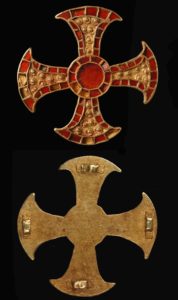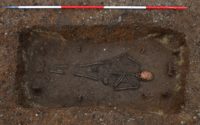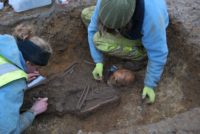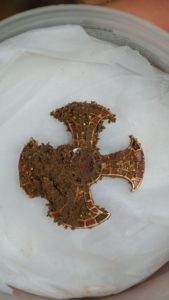 The gold and garnet pectoral cross found in a bed burial of a wealthy young Anglo-Saxon girl has been donated to University of Cambridge’s Museum of Archaeology and Anthropology (MAA). Landowners Gosvenor gifted the rare and valuable piece to the museum under the terms of the 1996 Treasures Act, forgoing the ex gratia reward the landowners of a treasure find are entitled to. In this case, the reward for the cross along was likely to be more than £80,000, so this is a significant donation for a company to make on a purely pecuniary level.
The gold and garnet pectoral cross found in a bed burial of a wealthy young Anglo-Saxon girl has been donated to University of Cambridge’s Museum of Archaeology and Anthropology (MAA). Landowners Gosvenor gifted the rare and valuable piece to the museum under the terms of the 1996 Treasures Act, forgoing the ex gratia reward the landowners of a treasure find are entitled to. In this case, the reward for the cross along was likely to be more than £80,000, so this is a significant donation for a company to make on a purely pecuniary level.
 That’s nothing compared to its historical value. The 7th century grave was discovered in 2011 by the Cambridge Archaeological Unit in the village of Trumpington Meadows just three miles south of Cambridge during a survey excavation of a site slated for development. The teenager had been laid to rest on a bed, probably the one she had slept on in life, adorned with her most precious gold and garnet jewels. While most of her bed was gone, its wood frame and straw mattress decayed to nothingness, the iron brackets did survive to bear witness to what had once been her final resting furnishings. This was only the 15th bed burial ever found in Britain.
That’s nothing compared to its historical value. The 7th century grave was discovered in 2011 by the Cambridge Archaeological Unit in the village of Trumpington Meadows just three miles south of Cambridge during a survey excavation of a site slated for development. The teenager had been laid to rest on a bed, probably the one she had slept on in life, adorned with her most precious gold and garnet jewels. While most of her bed was gone, its wood frame and straw mattress decayed to nothingness, the iron brackets did survive to bear witness to what had once been her final resting furnishings. This was only the 15th bed burial ever found in Britain.
 At her neck, archaeologists found a gold and garnet pectoral cross. Intricate in design with the highest quality craftsmanship, the cross is only the fifth of its kind ever found. The finely worked gold and cut garnets are reminiscent of several pieces in the Staffordshire Hoard and archaeologists believe they were reserved for the wealthiest, most important people, which would make the young lady one of the elite of Anglo-Saxon society, perhaps even royalty.
At her neck, archaeologists found a gold and garnet pectoral cross. Intricate in design with the highest quality craftsmanship, the cross is only the fifth of its kind ever found. The finely worked gold and cut garnets are reminiscent of several pieces in the Staffordshire Hoard and archaeologists believe they were reserved for the wealthiest, most important people, which would make the young lady one of the elite of Anglo-Saxon society, perhaps even royalty.
 The early date of the find is also immensely significant because the cross marks the girl as one of the earliest Christian Anglo-Saxons known. Christianity spread throughout Anglo-Saxon society from the top down, so it’s eminently possible that she was an early convert. The presence of additional grave goods characteristic of pre-Christian funerary practices underscore what a transitional time. Those grave goods, including another splendid piece of gold and garnet jewelry (a pin), an iron knife, glass beads and a chain which hung off her belt, are also part of the MAA collection now.
The early date of the find is also immensely significant because the cross marks the girl as one of the earliest Christian Anglo-Saxons known. Christianity spread throughout Anglo-Saxon society from the top down, so it’s eminently possible that she was an early convert. The presence of additional grave goods characteristic of pre-Christian funerary practices underscore what a transitional time. Those grave goods, including another splendid piece of gold and garnet jewelry (a pin), an iron knife, glass beads and a chain which hung off her belt, are also part of the MAA collection now.
The cross and other grave goods from the very rare bed burial will be put on temporary display while a new bespoke display case is created to show off the cross to its full advantage.
The Museum also hopes to host public lectures at which the context and significance of the cross will be explained.
“Our ultimate goal is to ensure that the importance of this magnificent and mysterious cross is recognised locally, nationally and internationally through research, exhibition and publication,” added [MMA Senior Curator Judy] Joy.
“The Trumpington Cross offers unique insights into the origins of English Christianity and we feel very lucky to be able to put it on display at the Museum of Archaeology and Anthropology just a few, short miles away from where this beautiful artefact was discovered.”